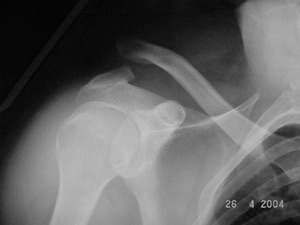Introduction
Anatomy
Cause
Symptoms
Diagnosis
Non-surgical treatment
Surgical treatment
Rehabilitation
Prevention
Introduction
Shoulder separation is a fairly common injury that occurs in athletes. It should not be viewed as a shoulder dislocation as it is very different from it.
Anatomy
The main joint in the shoulder is formed by the upper arm bone (humerus) and the shoulder blade (scapula). The part of the scapula that makes up the roof of the shoulder is called the acromion. The joint where the acromion and the clavicle (collarbone) meet is called the acromioclavicular joint, which is located at the top of the shoulder. The joint acts like a strut to help increase the range of movement of the scapula.

Cause
The acromioclavicular joint is commonly injured when you fall on the tip of your shoulder or on an outstretched arm, usually during sports activities. The ligaments around the joint may be injured from just a simple sprain or it may experience a complete tear, depending on the severity of the injury. As a result, the trauma will separate the acromion and clavicle, causing a sprain or true dislocation, with different severities of injury according to the degree of displacement between the two bones.
Symptoms
Pain and bruising on the top of the injured shoulder are the usual symptoms of an acromioclavicular joint injury. The pain may sometimes be more severe when you try to lift up the arm up. A painful bump may be felt over the top of the shoulder, signifying the separation of the acromion from the clavicle. Passive horizontal adduction of the shoulder will exaggerate the pain.
Diagnosis
Clinical examinations with local tenderness and palpable lump at the acromioclavicular joint will help an orthopaedic surgeon to diagnose the injury. Occasionally, the patient will be asked to tie a weight on an affected hand during the X-ray to stress the joint and to make the sprain or dislocation more obvious.
Non-surgical treatment
Sprains or the majority of minor dislocations of the acromioclavicular joint require only initial icing, anti-inflammatory medication for pain and swelling control as well as an arm sling to rest the joint for a few days to three to four weeks, followed by exercises to recover the range of motion and strength of the shoulder joint. The lump on the top of the shoulder will usually persist, despite the healing of the joint for around four to six weeks, but it does not affect the function of the shoulder.
Surgical treatment
Only the more severe dislcoations require stabilsation or reduction surgeries. In addition, surgeries are sometimes be warranted in athletes and labourers who engage in repetitive and heavy overhead activities. The choice of surgery also varies and includes joint reduction, stabilisation with or withour ligament repair or reconstruction, as well as resection of the distal clavicle, depending on the type of injury and residual disability. Operation is also necessary if conservative treatment fails, for example, if the patient experiences persistent pain and unacceptable deformity after several months of non-surgical treatment.
Rehabilitation
Gradual range-of-motion exercises will start soon after the surgery and will progress depending on the types of surgery performed. Lifting is usually limited for three to six weeks, following which progressive exercises can be performed as symptoms allow.
Most patients can return to their full functions after this injury, even if there is a residual lump on the top of the shoulder. Whether treated conservatively or surgically, the shooulder will require rehabilitation to restore and rebuild motion, strength and flexibility.
Prevention
There are no specific prevention measures available.
Dr. CHAN, Wai-lam